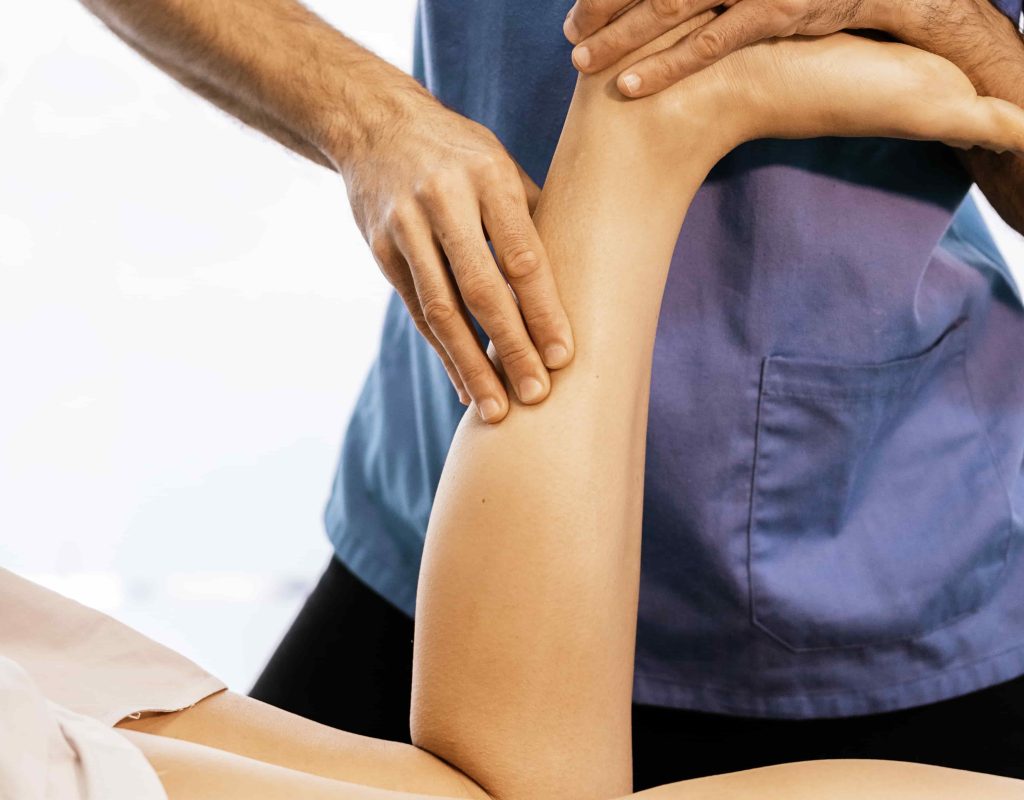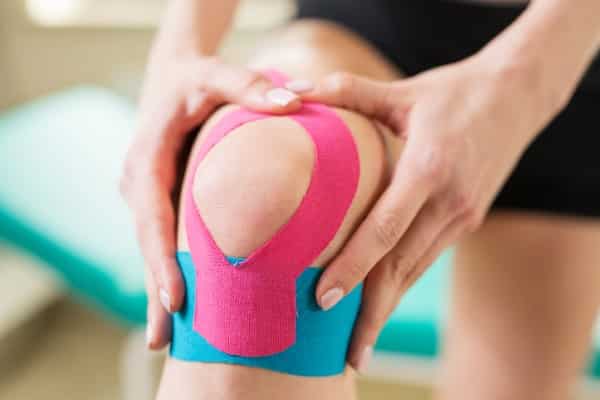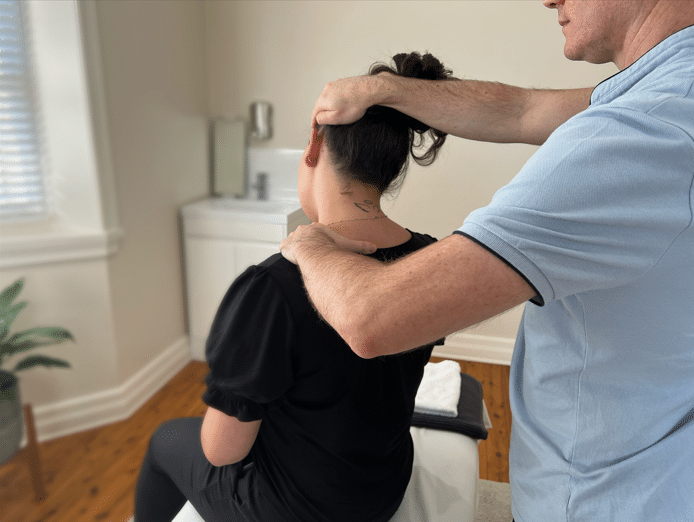- 02 9712 1736
- [email protected]
- 212 Great North Road, Five Dock, NSW 2046
- Open 7 days a week
Osgood-Schlatter’s Disease is a condition that commonly affects adolescents going through growth spurts. It is associated with knee pain and swelling at the tibial tubercle, which is the point where the patellar tendon attaches to the shinbone. Osgood Schlatter’s Disease is often caused by repetitive strain from activities like running and jumping and as such is more common in active individuals.

Osgood-Schlatter’s Disease is a repetitive strain injury that predominantly affects adolescents going through growth spurts, typically between the ages of 11 and 14. This condition primarily involves the tibial tubercle, a point of attachment on the shinbone where the patellar tendon attaches to. Activities like running, jumping, or other high-impact movements can cause repetitive stress on the patellar tendon, leading to inflammation, swelling, and pain at the tibial tubercle in adolescents.
Osgood-Schlatter’s Disease is generally self limiting and temporary. Most adolescents outgrow the symptoms as their bones mature and the growth plates harden. In rare cases, the pain may persist into adulthood, but it usually does not cause long-term problems once bone maturation is complete.
Osgood-Schlatter’s Disease often results in anterior knee pain, swelling, and tenderness at the patellar tendon insertion site. Pain is often localized at the tibial tubercle, where the patellar tendon attaches to the shin bone, and can appear as a noticeable bump beneath the kneecap. For many, this bony bump becomes more prominent and painful during physical activities, such as running, jumping, or climbing stairs.

The intensity of the symptoms can vary, with some adolescents experiencing mild discomfort while others face significant pain that interferes with daily activities. Symptoms often worsen with physical exertion, leading to increased pain and tightness in the thigh muscles. Symptoms can sometimes present bilaterally, affecting one or both knees, though it is also common for only one knee to be affected.
Early recognition of these symptoms aids in managing the condition, enabling young athletes to continue their activities with suitable modifications and treatments.

Osgood-Schlatter’s Disease arises from repetitive strain injuries caused by repeated motions or activities that stress the patellar tendon. The repetitive pulling of the tendon on the growth plate of the shin bone during activities such as running and jumping is a significant contributory factor. Participating in sports with frequent running, jumping, or quick directional changes, such as basketball, football, volleyball, and gymnastics, significantly heightens the risk of developing this condition.
However, even those who are not very active can develop the condition, especially if they have tight leg muscles, which can predispose them to this type of injury. The rapid growth spurts experienced by adolescents can also contribute, as the bone growth may outpace the ability of the muscles and tendons to adapt, leading to increased tension and strain.
Diagnosis requires a detailed physical examination by a healthcare professional, who will assess knee pain by palpating on the tibial tubercle. This area is typically sensitive in cases of Osgood-Schlatter’s Disease, and the examination helps pinpoint the exact location of pain and swelling. The physical examination often includes checking for tenderness around the tibial tuberosity and observing any swelling or prominent bony bumps.
In certain instances, imaging tests such as X-rays may be used to closely examine the knee. These tests are primarily used to rule out other potential issues rather than to confirm the diagnosis of Osgood-Schlatter’s Disease. The X-rays can help differentiate Osgood-Schlatter’s Disease from other knee conditions that might present with similar symptoms, ensuring that the appropriate treatment plan is followed.
Treatment of Osgood-Schlatter’s Disease typically includes rest, ice, modifying activities, and physical therapy to alleviate pain and reduce swelling. Cold packs can be effective in managing symptoms, providing immediate relief from pain and inflammation. It is highly important to rest and take breaks from high-impact activities, particularly when running causes a limp due to pain.
However, rest and ice will only serve to manage symptoms short term as pain can return quickly when resuming activity. You may notice that the same activity now result in even more pain. Alternatively, pain intensity may be similar but now starts after less time spent on the activity. This is where physical therapy comes in. In severe cases, surgical intervention may be required, although it is rare and typically reserved for situations where conservative treatments fail to provide severe pain relief.
Physical therapy plays an important role in the management of Osgood-Schlatter’s Disease, enabling young athletes to maintain physical activity while managing symptoms effectively. Manual therapy can be effective to reduce tightness in the leg muscles and improve your lower limb joint mobility thereby reducing mechanical stress and tension on your knees.
Your healthcare provider will prescribe stretching exercises for the quadriceps, hamstrings, and calves which will help to alleviate symptoms and support recovery. You will also be given strengthening exercises for muscles around the knee, which can significantly reduce the strain on the patellar tendon, easing the stress on the tibial tubercle. Other exercises to enhance knee stability and flexibility, can also be beneficial to prevent recurrence.


Effective management of Osgood-Schlatter’s Disease involves a combination of pain relief strategies and preventive measures to avoid recurrence. Here are some key strategies:
1. Reduce activities that cause pain, such as running or jumping.
2. Use ice to reduce pain and swelling after activity. Use nonsteroidal anti-inflammatory drugs (NSAIDs) for additional pain relief.
3. Consider physical therapy for a more long term solution and to prevent recurrences.
4. Knee pads or a patellar tendon strap during physical activities can offer additional support and alleviate discomfort.
For young athletes, Osgood-Schlatter’s Disease can be a significant hindrance, but it doesn’t have to end their sports careers. Continued participation in sports is possible as long as appropriate management strategies are being followed. Cross-training with varied physical activities can help prevent overuse injuries while maintaining fitness.
Osgood-Schlatter’s Disease is particularly common among young athletes in sports that require running, jumping, or quick directional changes. It is important to rest and not overdo these activities over short periods of time to prevent cases of Osgood-Schlatter’s Disease.
Most symptoms resolve when bone growth ceases, typically by the end of adolescence. However, approximately 10% of individuals may still experience symptoms into adulthood. While a thickened prominence at the tibial tubercle may remain, it is usually asymptomatic and does not interfere with daily activities.

Osgood-Schlatter’s Disease, though painful and disruptive, is a manageable condition with a generally positive long-term outlook. Recognizing the symptoms early, understanding the causes, and following appropriate treatment options can help young athletes continue their activities with minimal interruption. Effective pain management and preventive strategies are crucial in ensuring that the condition does not recur. Encouragingly, most adolescents outgrow OSD as their bones mature, and with proper care, they can look forward to a pain-free future.
Forest Lodge, Annandale, Glebe, Leichhardt, Balmain, Haberfield, Canada Bay, Rozelle, Rodd Point, Wareemba, Stanmore, Petersham, Lilyfield, Hunters Hill, Enfield, Cabarita, Mortlake, Rhodes, Burwood Heights, Birchgrove, Gladesville, Huntleys Point, Abbotsford, Ashfield, Croydon Park, Croydon, Chiswick, Russell Lea, Burwood, Strathfield, Concord, Drummoyne, North Strathfield, Liberty Grove, Dulwich Hill, Lewisham, Camperdown, Ashbury, Homebush, Homebush West, Woolwich, Henley, Summer Hill, Sydney Olympic Park


About
Five Dock Osteopathic & Chiropractic is located in Canada Bay, in Sydney’s Inner West. Servicing suburbs including Burwood, Croydon, Drummoyne, Five Dock, Haberfield, Concord, Abbotsford, Chiswick, Leichhardt, Wareemba, Russell Lea, Summer Hill, Strathfield.
Clinic hours
Monday, Tuesday, Thursday 7AM – 7PM
Wednesday, Friday 7AM – 6PM
Saturday 7AM – 2PM
Sunday 8AM – 2PM
Contact details